Spacecraft
Click for more information
Juno uses a spinning, solar-powered spacecraft in a highly elliptical polar orbit that avoids most of Jupiter’s high-radiation regions. The designs of the individual instruments are straightforward, and the mission did not require the development of any new technologies.
For Juno, like NASA’s earlier Pioneer spacecraft, spinning makes the spacecraft’s pointing extremely stable and easy to control. Just after launch, and before its solar arrays are deployed, Juno will be spun up by rocket motors on its still-attached second-stage rocket booster. Juno’s planned spin rate varies during the mission: 1 RPM for cruise, 2 RPM for science operations, and 5 RPM for main engine maneuvers.
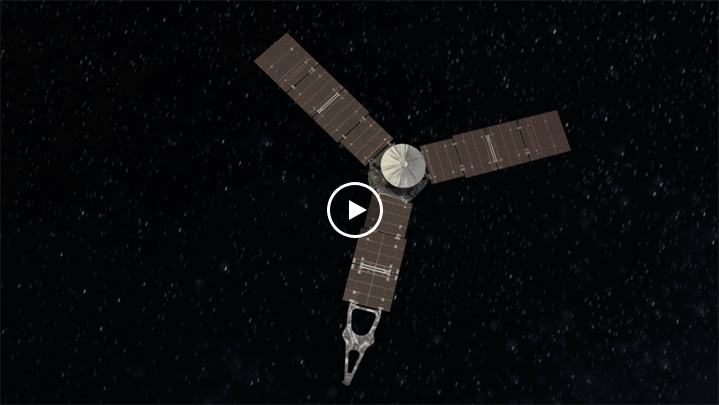
This animation illustrates the rotation of the Juno spacecraft as it moves through orbit
To simplify and decrease weight, all instruments are fixed. While in orbit at Jupiter, the spinning spacecraft will sweep the fields of view of its instruments through space once for each rotation. At two rotations per minute, the instruments’ fields of view sweep across Jupiter about 240 times in the two hours it takes Juno to fly from pole to pole.
The spacecraft’s main body measures 11.5 feet (3.5 meters) tall and 11.5 feet (3.5 meters) in diameter. The spacecraft’s hexagonal two-deck structure uses composite panel and clip construction for decks, central cylinder and gusset panels. Polar mounted off-center spherical tanks provide spinning spacecraft designs with high stability.
For weight savings and redundancy, Juno uses a dual- mode propulsion subsystem, with a bi-propellant main engine and mono-propellant reaction control system thrusters.
The Leros-1b main engine is a 645-Newton bi-propellant thruster using hydrazine– nitrogen tetroxide. Its engine bell is enclosed in a micrometeoroid shield that opens for engine burns. The engine is fixed to the spacecraft body firing aft and is used for major maneuvers and flushing burns.
The 12 reaction control system thrusters are mounted on four rocket engine modules. They allow translation and rotation around three axes. They also are used for most trajectory correction maneuvers.
Command and data handling includes a RAD750 flight processor with 256 megabytes of flash memory and 128 megabytes of DRAM local memory. It provides 100 Mbps total instrument throughput, more than enough for payload requirements.

To protect sensitive spacecraft electronics, Juno carries the first-of-its-kind radiation- shielded electronics vault, a critical feature for enabling sustained exploration in such a heavy radiation environment. Each of the titanium cube’s eight sides measures nearly 9 square feet (a square meter) in area, about a third of an inch (1 centimeter) in thickness, and 40 pounds (18 kilograms) in mass. This titanium box -- about the size of an SUV’s trunk -- encloses Juno’s command and data handling box (the spacecraft’s brain), power and data distribution unit (its heart), and about 20 other electronic assemblies. The whole vault weighs about 400 pounds (200 kilograms).
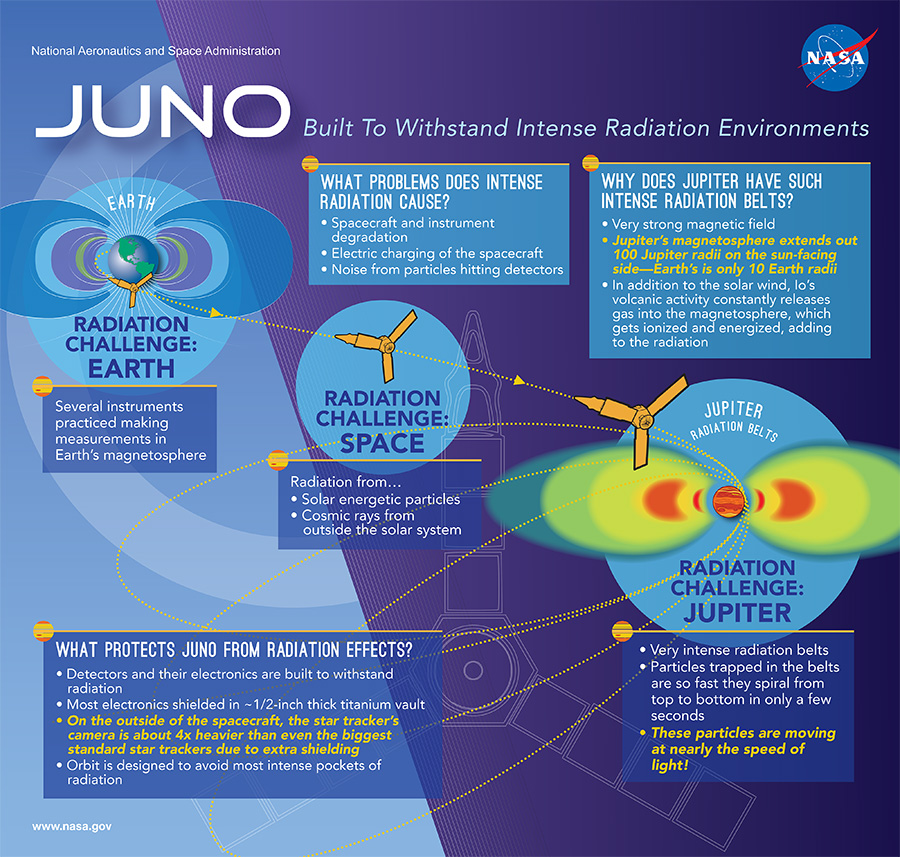
Click to enlarge (pdf)
Credit: NASA's Goddard Space Flight Center
Juno’s Electrical Power Subsystem manages the spacecraft power bus and distribution of power to payloads, propulsion, heaters and avionics. The power distribution and drive unit monitors and manages the spacecraft power bus, manages the available solar array power to meet the spacecraft load and battery state of charge, and provides controlled power distribution.
Power generation is provided by three solar arrays consisting of 11 solar panels and one MAG boom. Two 55 amp-hour lithium-ion batteries provide power when Juno is off-sun or in eclipse, and are tolerant of the Jupiter radiation environment. The power modes during science orbits are sized for either data collection during an orbit emphasizing microwave radiometry or gravity science.
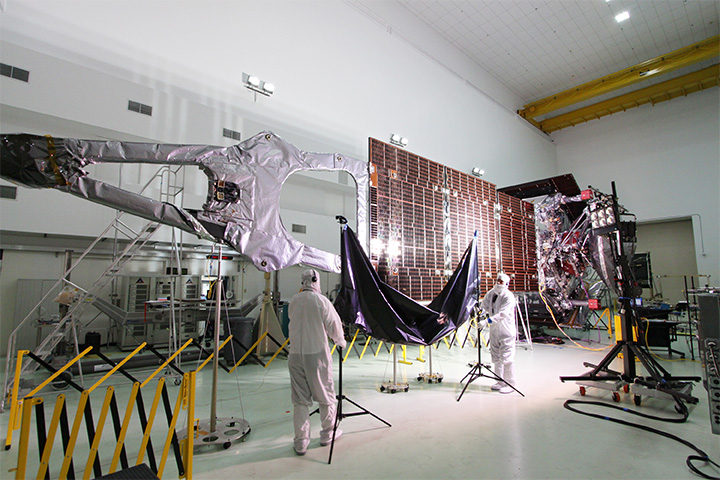
Technicians test Juno's solar arrays in preparation for launch at NASA's Kennedy Space Center.Credit: NASA
Jupiter’s orbit is five times farther from the sun than Earth’s orbit, and the giant planet receives 25 times less sunlight than Earth. Juno will be the first solar-powered spacecraft designed to operate at such a great distance from the sun, which means the surface area of solar panels required to generate adequate power is quite large.
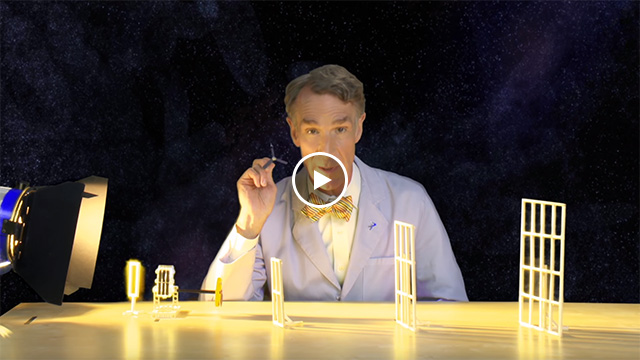
Juno benefits from advances in solar cell design with modern cells that are 50 percent more efficient and radiation-tolerant than silicon cells available for space missions 20 years ago. The mission’s power needs are modest. Juno has energy-efficient science instruments. Solar power is possible on Juno due to the energy-efficient instruments and spacecraft, a mission design that can avoid Jupiter’s shadow, and a polar orbit that minimizes the total radiation.
The spacecraft’s three solar panels extend outward from Juno’s hexagonal body, giving the overall spacecraft a span of more than 66 feet (20 meters). The solar panels will remain in sunlight continuously from launch through end of mission, except for a few minutes during the Earth flyby. Before deployment in space, the solar panels are folded into four-hinged segments so the spacecraft can fit into the launch vehicle’s payload fairing.
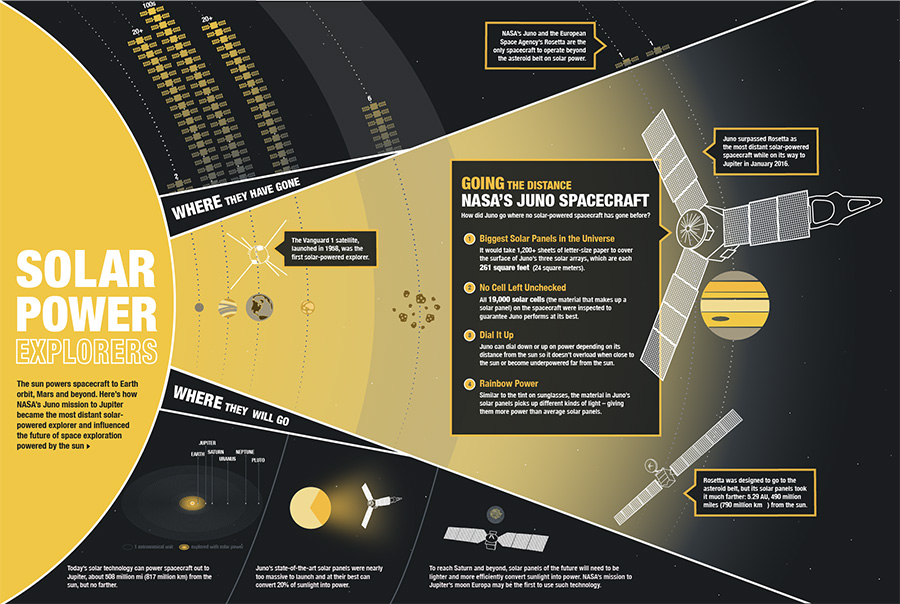
Click to enlarge
Juno’s thermal control subsystem uses a passive design with heaters and louvers. The main component of the thermal control subsystem consists of an insulated, louvered electronics vault atop an insulated, heated propulsion module. This design accommodates all mission thermal environments from Earth orbit to Jupiter orbital operations. During cruise, while the spacecraft is close to the sun, the high-gain antenna is used as a heat shield to protect the vault avionics.
Most instrument electronics are contained within the radiation vault and are thermally managed as part of the vault thermal control system. Science sensors are externally mounted to the deck and are individually blanketed and heated to maintain individual temperature limits.

Thermal blankets being installed on Juno's magnetometer boom. Credit: NASA
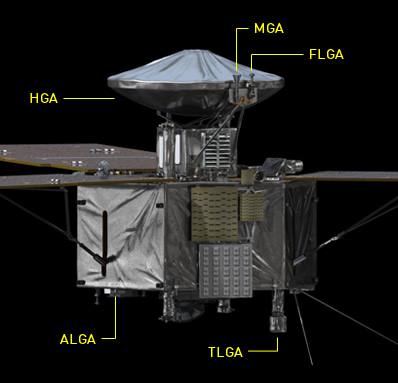
Juno's telecom antennas consist of a large high-gain antenna, a medium gain antenna, forward and aft low gain antennas and a toroidal low gain antenna. Credit: NASA/JPL-Caltech
The gravity science and telecom subsystem provides X-band command uplink and engineering telemetry and science data downlink for the entire post-launch, cruise and Jupiter orbital operations. The subsystem also provides for dual- band (X- and Ka-band) Doppler tracking for gravity science at Jupiter.
Along with the spacecraft subsystems and science gear, the Juno spacecraft carries some very special guests on board.
Juno carries the 1.5-inch likeness of Galileo Galilei, the Roman god Jupiter and his wife Juno. The inclusion of the three mini-statues, or figurines, is part of a joint outreach and educational program developed as part of the partnership between NASA and the LEGO Group to inspire children to explore science, technology, engineering and mathematics.
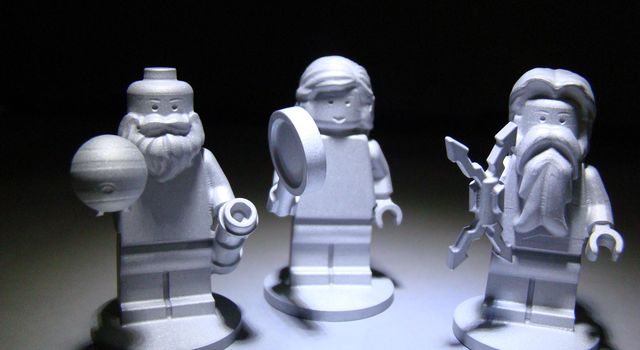
The Juno LEGO minifigures, from left to right: Galileo, Juno and Jupiter. Credit: NASA/JPL-Caltech/LEGO
In Greek and Roman mythology, Jupiter drew a veil of clouds around himself to hide his mischief. From Mount Olympus, Juno was able to peer through the clouds and reveal Jupiter's true nature. Juno holds a magnifying glass to signify her search for the truth, while her husband holds a lightning bolt. The third LEGO crew member, Galileo Galilei, made several important discoveries about Jupiter, including the four largest satellites of Jupiter (named the Galilean moons in his honor). Of course, the miniature Galileo has his telescope with him on the journey.
A plaque dedicated to Galileo Galilei is also carried aboard Juno. The plaque, which was provided by the Italian Space Agency, measures 2.8 by 2 inches (71 by 51 millimeters), is made of flight-grade aluminum and weighs 0.2 ounces (6 grams). It was bonded to Juno's propulsion bay with a spacecraft-grade epoxy. The graphic on the plaque depicts a self-portrait of Galileo. It also includes -- in Galileo's own hand -- a passage he made in 1610 of observations of Jupiter, archived in the Biblioteca Nazionale Centrale in Florence.
Galileo's text included on the plaque reads as follows: "On the 11th it was in this formation -- and the star closest to Jupiter was half the size than the other and very close to the other so that during the previous nights all of the three observed stars looked of the same dimension and among them equally afar; so that it is evident that around Jupiter there are three moving stars invisible till this time to everyone."
Among his many achievements, Galileo Galilei discovered that moons orbited Jupiter in 1610. These Galilean moons, as they are now called, are Io, Europa, Ganymede and Callisto.
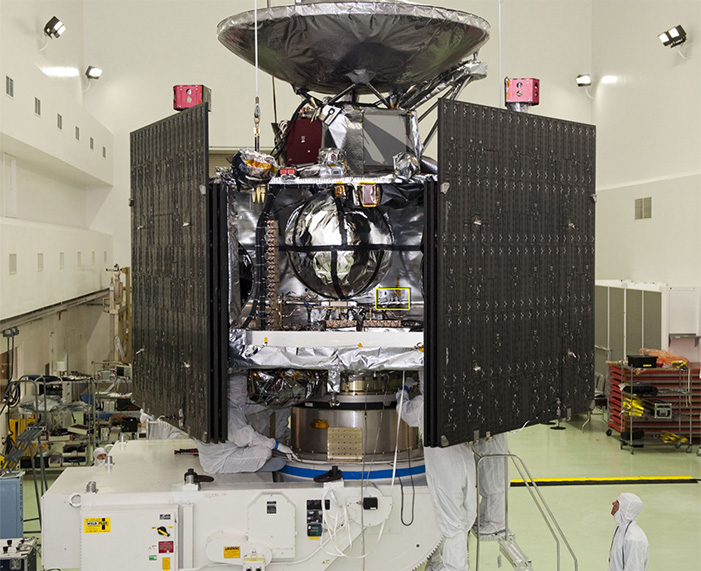
The location of the minifigures onboard Juno, indicated by a yellow rectangle. Credit: NASA/KSC
The Juno spacecraft carries a payload of 29 sensors, which feed data to nine onboard instruments. Eight of these instruments (MAG, MWR, Gravity Science, Waves, JEDI, JADE, UVS, JIRAM) are considered the science payload. One instrument, JunoCam, is aboard to generate images for education and public outreach.
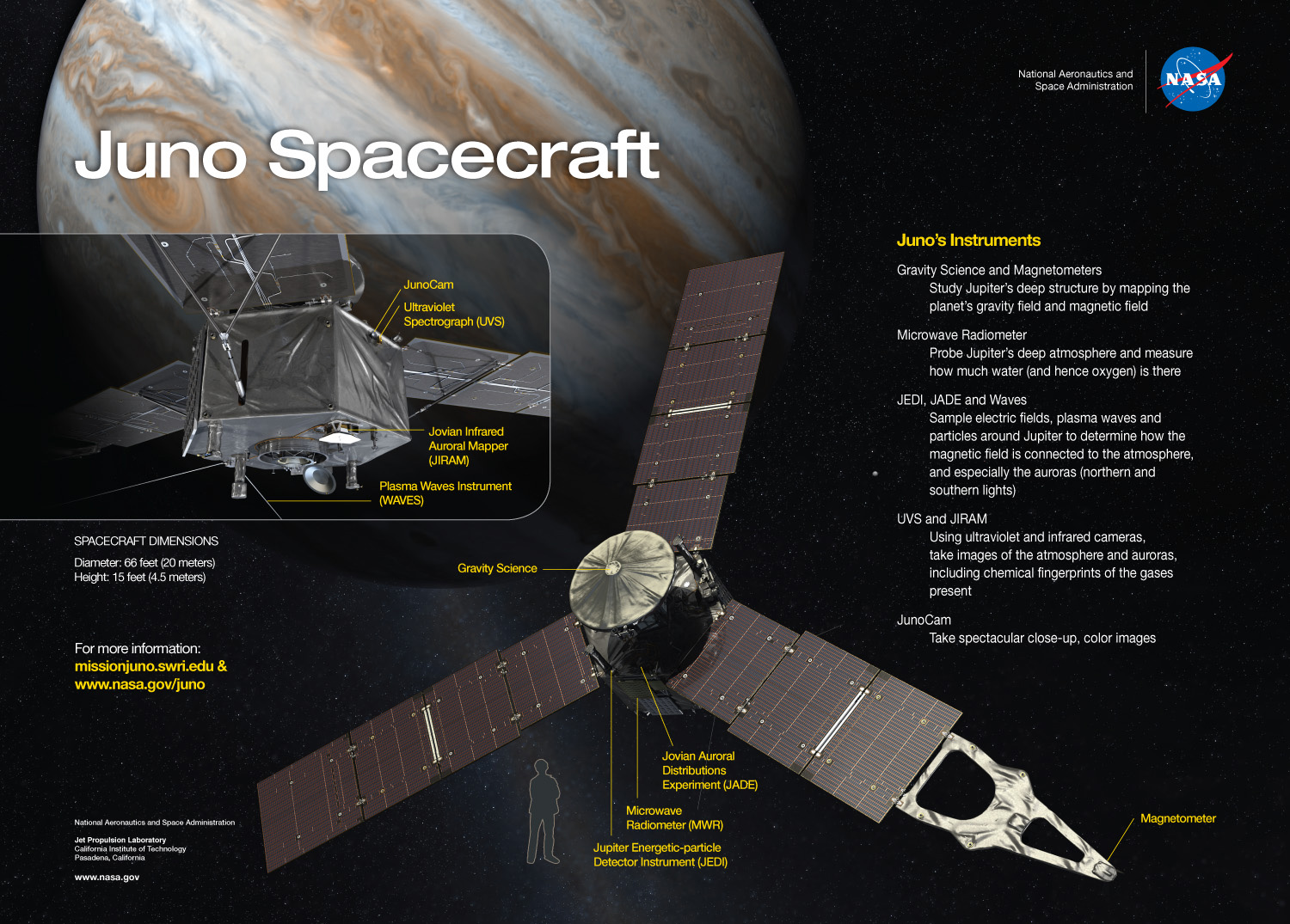
Click to enlarge
Primary science observations are obtained within three hours of closest approach to Jupiter, although calibrations, occasional remote sensing and magnetospheric science observations are planned throughout the science orbits around Jupiter.
Juno is spin-stabilized. Because of the spacecraft mission design and the fact that its science instruments were all developed together, there is no need for a scan platform to point instruments in different directions. Gravity science and microwave sounding of the atmosphere observations are obtained through orientation of the spacecraft’s spin plane. All other experiments utilize ride-along pointing and work in either one or both orientations. This design allows for very simple operations.
For more in-depth information on Juno's science instruments, go to the Science section.